| Listing 1 - 8 of 8 |
Sort by
|
Book
ISBN: 019503029X 0195030281 Year: 1982 Publisher: New York (N.Y.): Oxford university press
Abstract | Keywords | Export | Availability | Bookmark
 Loading...
Loading...Choose an application
- Reference Manager
- EndNote
- RefWorks (Direct export to RefWorks)
Architects --- International style (Architecture) --- Biography. --- Neutra, Richard Joseph, --- Architecture, Modern --- Modern movement (Architecture) --- Biography --- Neutra, Richard, --- Neutra, Richard J. --- Neutra, Richard
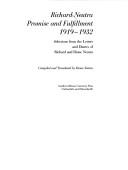
ISBN: 080931228X Year: 1986 Publisher: Carbondale Southern Illinois university press
Abstract | Keywords | Export | Availability | Bookmark
 Loading...
Loading...Choose an application
- Reference Manager
- EndNote
- RefWorks (Direct export to RefWorks)
Architects --- -Wives --- -Spouses --- Women --- Housewives --- Married women --- Professional employees --- Correspondence --- Neutra, Dione --- Neutra, Richard Joseph --- Wives --- Correspondence. --- -Correspondence --- Spouses --- Neutra, Dione. --- Neutra, Richard Joseph, --- Neutra, Richard, --- Neutra, Richard J. --- Neutra, Richard
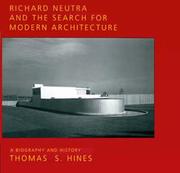
ISBN: 0520085892 Year: 1994 Publisher: Berkeley University of California Press
Abstract | Keywords | Export | Availability | Bookmark
 Loading...
Loading...Choose an application
- Reference Manager
- EndNote
- RefWorks (Direct export to RefWorks)
Neutra, Richard --- Architects. Urbanists --- anno 1900-1999 --- United States --- Architects --- International style (Architecture) --- Architecture --- Architectes --- Style international (Architecture) --- Biography. --- History --- Biographies --- Histoire --- Neutra, Richard Joseph, --- Richard Neutra 1892-1970 (°Vienna) --- Architectuur ; California ; 20ste eeuw ; Richard Neutra --- 72.07 --- Architecten. Stedenbouwkundigen A - Z --- Architecture, Modern --- Modern movement (Architecture) --- Biography --- Neutra, Richard, --- Neutra, Richard J. --- United States of America
Book
ISBN: 0931228018 0931228026 Year: 1979 Publisher: Santa Monica Arts and architecture press
Abstract | Keywords | Export | Availability | Bookmark
 Loading...
Loading...Choose an application
- Reference Manager
- EndNote
- RefWorks (Direct export to RefWorks)
Architects --- -Architecture --- -72.03 --- Architecture, Western (Western countries) --- Building design --- Buildings --- Construction --- Western architecture (Western countries) --- Art --- Building --- Professional employees --- Correspondence --- Bouwstijlen. Architectuurscholen. Architectuurstromingen. Bouwkunst: periodenen invloeden --- Design and construction --- Neutra, Richard Joseph --- Schindler, R. M. --- Sullivan, Louis H. --- Architecture --- History --- Neutra, Richard Joseph, --- Sullivan, Louis H., --- 72.03 Bouwstijlen. Architectuurscholen. Architectuurstromingen. Bouwkunst: periodenen invloeden --- 72.03 --- Architecture, Modern --- Schindler, Rudolph Michael, --- Schindler, Rudolph M., --- Schindler, Rudolf Michael, --- Neutra, Richard, --- Neutra, Richard J. --- Neutra, Richard
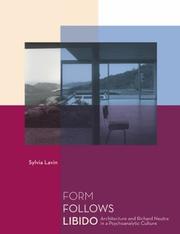
ISBN: 0262122685 Year: 2004 Publisher: Cambridge (Mass.) MIT press
Abstract | Keywords | Export | Availability | Bookmark
 Loading...
Loading...Choose an application
- Reference Manager
- EndNote
- RefWorks (Direct export to RefWorks)
Architects --- Modern movement (Architecture) --- Architectes --- Mouvement moderne (Architecture) --- Psychology. --- Psychologie --- Neutra, Richard Joseph, --- Criticism and interpretation. --- Neutra, Richard Joseph --- -Architects --- -Modern Movement (Architecture) --- 159.9 --- 72 --- Neutra, Richard --- 72 NEUTRA, RICHARD --- 72.036 <73> --- Modernism (Architecture) --- Modernist architecture --- Architecture, Modern --- International style (Architecture) --- Professional employees --- Criticism and interpretation --- Psychology --- Architectuur --- Architectuur. Bouwkunst--NEUTRA, RICHARD --- Moderne bouwkunst. Architectuur van de 20e eeuw--Verenigde Staten van Amerika. VSA. USA --- Modern movement (Architecture). --- 72.036 <73> Moderne bouwkunst. Architectuur van de 20e eeuw--Verenigde Staten van Amerika. VSA. USA --- 72 NEUTRA, RICHARD Architectuur. Bouwkunst--NEUTRA, RICHARD --- Neutra, Richard, --- Neutra, Richard J.
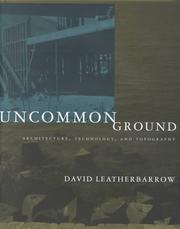
ISBN: 0262278049 1423725247 9780262278041 9780262338547 0262338548 9780262122306 9781423725244 0262122308 Year: 2000 Publisher: Cambridge, Mass. : MIT Press,
Abstract | Keywords | Export | Availability | Bookmark
 Loading...
Loading...Choose an application
- Reference Manager
- EndNote
- RefWorks (Direct export to RefWorks)
How building and site, technology and topography, interact to create successful buildings and resolve theoretical issues in practice.Although both are central to architecture, siting and construction are often treated as separate domains. In Uncommon Ground, David Leatherbarrow illuminates their relationship, focusing on the years between 1930 and 1960, when utopian ideas about the role of technology in building gave way to an awareness of its disruptive impact on cities and culture. He examines the work of three architects, Richard Neutra, Antonin Raymond, and Aris Konstantinidis, who practiced in the United States, Japan, and Greece respectively.Leatherbarrow rejects the assumption that buildings of the modern period, particularly those that used the latest technology, were designed without regard to their surroundings. Although the prefabricated elements used in the buildings were designed independent of siting considerations, architects used these elements to modulate the environment. Leatherbarrow shows how the role of walls, the traditional element of architectural definition and platform partition, became less significant than that of the platforms themselves, the floors, ceilings, and intermediate levels. He shows how frontality was replaced by the building's four-sided extension into its surroundings, resulting in frontal configurations previously characteristic of the back. Arguing that the boundary between inside and outside was radically redefined, Leatherbarrow challenges cherished notions about the autonomy of the architectural object and about regional coherence. Modern architectural topography, he suggests, is an interplay of buildings, landscapes, and cities, as well as the humans who use them. The conflict between technological progress and cultural continuity, Leatherbarrow claims, exists only in theory, not in the real world of architecture. He argues that the act of building is not a matter of restoring regional identity by re-creating familiar signs, but of incorporating construction into the process of topography's perpetual becoming.
Building sites --- Architecture and technology --- Architecture --- Art, Architecture & Applied Arts --- Planning --- Environmental aspects --- Architecture, Western (Western countries) --- Building design --- Buildings --- Construction --- Western architecture (Western countries) --- Technology and architecture --- Site planning --- Design and construction --- Art --- Building --- Technology --- Architecture and technology. --- Planning. --- Environmental aspects. --- Neutra, Richard Joseph, --- Raymond, Antonin, --- Kōnstantinidēs, Arēs, --- Criticism and interpretation. --- ARCHITECTURE/Architectural History/Modern Architecture --- Konstantinidis, Aris, --- Konsztantinidisz, Arisz, --- Κωνσταντινίδης, Αρης, --- Rajman, Antonin, --- Neutra, Richard, --- Neutra, Richard --- Neutra, Richard J. --- Building sites - Planning --- Architecture - Environmental aspects --- Neutra, Richard Joseph, - 1892-1970 - Criticism and interpretation --- Raymond, Antonin, - 1888- - Criticism and interpretation --- Konstantinides, Ares, - 1913- - Criticism and interpretation
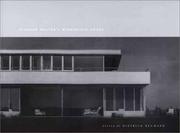
ISBN: 0300092032 Year: 2001 Publisher: Cambridge (Mass.): Harvard university. Graduate school of design
Abstract | Keywords | Export | Availability | Bookmark
 Loading...
Loading...Choose an application
- Reference Manager
- EndNote
- RefWorks (Direct export to RefWorks)
International style (Architecture) --- Lost architecture --- Architecture --- Style international (Architecture) --- Monuments disparus --- History --- Histoire --- Neutra, Richard Joseph, --- Criticism and interpretation. --- Critique et interprétation --- Windshield House (Fishers Island, N.Y.) --- New York (State) --- New York (Etat) --- Building, structures etc. --- Constructions --- 72 NEUTRA, RICHARD --- 72.036 <73> --- -Lost architecture --- -Architectural heritage, Lost --- Buildings, Lost --- Demolished architecture --- Demolished buildings --- Destroyed architecture --- Destroyed buildings --- Lost architectural heritage --- Lost buildings --- Architecture, Modern --- Modern movement (Architecture) --- Architectuur. Bouwkunst--NEUTRA, RICHARD --- Moderne bouwkunst. Architectuur van de 20e eeuw--Verenigde Staten van Amerika. VSA. USA --- Neutra, Richard Joseph --- -Criticism and interpretation --- -Architectuur. Bouwkunst--NEUTRA, RICHARD --- 72.036 <73> Moderne bouwkunst. Architectuur van de 20e eeuw--Verenigde Staten van Amerika. VSA. USA --- 72 NEUTRA, RICHARD Architectuur. Bouwkunst--NEUTRA, RICHARD --- Critique et interprétation --- Architectural heritage, Lost --- Neutra, Richard, --- Neutra, Richard J. --- Neutra, Richard --- Critique et interprétation.
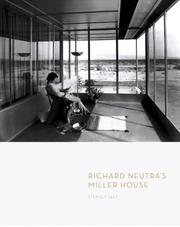
ISBN: 1568982747 9781568982748 Year: 2004 Publisher: St. Louis : New York, N.Y. : School of Architecture, Washington University ; Princeton Architectural Press,
Abstract | Keywords | Export | Availability | Bookmark
 Loading...
Loading...Choose an application
- Reference Manager
- EndNote
- RefWorks (Direct export to RefWorks)
At the dawn of his international fame, architect Richard Neutra was approached by a St. Louis socialite, Grace Lewis Miller, to design a small winter home on the edge of glamour-baked Palm Springs. Miller wanted an open, light-filled house that could also act as a studio for her fashionably avant-garde exercise course in posture and grace, "The Mensendieck System." This unique program, combined with the desert landscape and the proactive health-minded client appealed to the idealist in Neutra. The frequent, fervent dialog between Neutra and Miller, who had great mutual respect, produced a work of forward-thinking and artful architecture. In Richard Neutra's Miller House, Stephen Leet traces the conception and realization of the house, examines the complex relationship between architect and client, and shows how the Mensendieck System influenced the creation of this seminal Neutra project. Beautiful duotone photographs by Julius Shulman, excerpts from the detailed correspondence between Neutra and Miller, and sketches and drawing provide valuable insight into the design process. Like the houses of Albert Frey, a contemporary of Neutra's who also build in the desert, the Miller House shows how architecture , the California landscape, and an interest in well-being can intersect in a moment of the architectural sublime.
Architecture --- Mensendieck system --- Californie (États-Unis ; sud) --- Régions arides --- History --- Arid regions. --- Neutra, Richard Joseph, --- Miller, Grace Lewis, --- Critique et interprétation --- Criticism and interpretation. --- Homes and haunts --- Miller House (Palm Springs, Calif.) --- Palm Springs (Calif.) --- Buildings, structures, etc. --- Richard Neutra 1892-1970 (° Wenen, Oostenrijk) ; emigreerde in 1923 naar de Verenigde Staten --- Architectuur ; California ; 20ste eeuw ; Richard Neutra --- Woningbouw ; R. Neutra ; Miller House --- 72.07 --- Architecten. Stedenbouwkundigen A - Z --- Mensendieck method --- Mensendieck system of functional exercises --- Exercise therapy --- Architecture, Western (Western countries) --- Building design --- Buildings --- Construction --- Western architecture (Western countries) --- Art --- Building --- Desert architecture --- Architecture and climate --- Arid regions --- Deserts --- Design and construction --- Neutra, Richard, --- Neutra, Richard J. --- Palm Springs, Calif. --- Miller House (Palm Springs, Calif.). --- Régions arides. --- Neutra, Richard --- Architecture, Primitive --- Habitat --- Habitat individuel --- Architecture - 20e siecle. --- Neutra, Richard Joseph --- Californie --- Critique et interprétation. --- Californie (États-Unis ; sud) --- Régions arides. --- Critique et interprétation
| Listing 1 - 8 of 8 |
Sort by
|

 Search
Search Feedback
Feedback About UniCat
About UniCat  Help
Help News
News